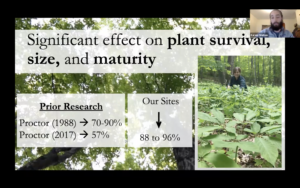Final report for GNE19-221
Project Information
American ginseng (Panax quinquefolius L.) is an herbaceous perennial plant native to the forests of eastern North America with a long history of use and harvest, and with a significant international market. To supply international demand, the plant is grown in the USA and Canada under artificial shade cloth. However, wild and wild-appearing ginseng roots command prices up to 100 times greater than roots cultivated in a field: $550–2200 (US$ dry kg) vs. $20–70 (US$ dry kg). Growing ginseng in a forested environment using a “wild-simulated” forest farming approach, where growers introduce ginseng into a forested environment and then let it grow with little to no intervention, allows forest farmers to access these higher prices and meet international demand. As climate change shifts growing conditions globally, there will be increasing opportunities for the forest farming of American ginseng internationally. In this study, we examined the main drivers of ginseng growth and development in a wild-simulated ginseng forest farm. We measured the range of environmental conditions and built statistical models to examine which factors were most important for ginseng vigor. We found that the amount of sunlight, even under highly shaded conditions, was the most important driver of ginseng establishment on the landscape, as well as ginseng plant size and development. Prior research indicates that additional factors including soil nutrient levels, moisture, and texture are important for the survival, growth, and development of wild and planted American ginseng, but our study did not show significant patterns of importance at this site. Our findings suggest that integrating silvicultural techniques such as forest thinning may enhance the productivity of wild-simulated ginseng operations while providing additional forest-based income with minimal impact on natural forest ecosystems.
This study led a number of insightful takeaways for current and prospective American ginseng forest farmers:
- In our study, levels of canopy shade were revealed to be the single largest factor in determining the establishment, size, and maturity of planted American ginseng in a forest environment. While conventional wisdom around selecting a good ginseng site suggests 70-90% shade cover is optimal, our research sites were quite shade, on the order of 86-96% shaded. Across our tests, the more sun our plots received the better the ginseng plants were doing. This suggests that forest farmers with especially shaded sites may consider a light thinning of the canopy or midstory to allow higher light levels to reach their ginseng plantings to increase establishment, maturation, and growth.
- We found that as our plots got shadier, the marginal benefit of planting more ginseng seed decreased. In other words, in sunnier plots planting more seed led to having more plants after three years. In our shadier plots, it didn't matter how much seed was planted, the number of plants that established after 3 years stayed the same. This suggests that forest farmers shouldn't bother planting more seed on their shadiest sites to compensate for slow growth rates – a lack of sunlight is negatively affecting ginseng establishment.
- Identify and quantify the importance of direct environmental variables on success (e.g., density and vigor) in wild-simulated American ginseng plantings.
- Examine the relationship between common proxy variables (e.g., aspect, indicator species) used in American ginseng siting and direct environmental measures necessary for plant growth and development.
- Provide data to farmers and land managers on the most useful and efficient variables for predicting ginseng growth and development in wild-simulated systems.
The purpose of this project was to identify the most important environmental variables driving growth and productivity of American ginseng in wild-simulated forest farming operations. Forest farming is an agroforestry practice which cultivates medicinal, edible, decorative, and handicraft crops under a forest canopy that is modified or maintained to provide shade levels and habitat which favor growth and enhance production (Chamberlain et al. 2009). American ginseng, Panax quinquefolius, is an understory plant which has been harvested for centuries due to its significant economic value, and is often the focus crop of forest farming operations. Wild ginseng roots can sell for over $1,000 a pound; this high value has caused the plant to become increasingly scarce in the wild (Turner and McGraw 2015). The forest farming of American ginseng has the potential to take pressure off of wild populations of the plant and to provide forest landowners with an additional and sustainable source of land-based income (Burkhart and Jacobson 2008).
Ginseng can be grown using three different cultivation methods: 1) field-cultivated (in tilled beds under artificial shade cloth with heavy fungicide application); 2) forest-grown (using a forest canopy to provide shade but tilling the soil underneath and applying fungicides); and 3) wild-simulated (planting seeds in a forest environment and then allowing them to grow input-free under natural conditions). Of the three methods, wild-simulated production requires the fewest inputs, incurs the lowest costs, is best for native forest, and produces roots of the highest value, with prices equaling that of wild ginseng, potentially over $1,000 a pound (Carroll and Apsley 2013).
The table below quantifies the financial potential of a successful wild-simulated ginseng planting, illustrating the potential gain to forest landowners across the region.
|
Wild-Simulated American Ginseng Production Profit Potential on ½ Acre* |
|
|
Time to first harvest |
7-12 years |
|
Seeds planted per ½ acre ($180 per lb.) |
10 lbs. |
|
Total labor per ½ acre (hours at $15 per hour) |
825 |
|
Tools, pest control, fertilizer, and other expenses |
$644 |
|
Total costs per ½ acre |
$14,819 |
|
Root yield per ½ acre |
80 lbs. |
|
Root price per dry lb. |
$850 |
|
Gross income per ½ acre |
$68,000 |
|
Net profit per ½ acre |
$53,181 |
*Adapted from Carroll and Apsley 2013
Like all agricultural operations, however, the probability of the venture depends on the survival of the crop. Unlike most crops, wild-simulated ginseng requires minimal inputs beyond the initial labor of planting. However, ginseng is very particular about where it grows, thriving on cool, moist slopes under a deciduous canopy (Cruse-Sanders 2004). Land managers use environmental indicators such as slope and aspect as well as “indicator species” to determine good planting sites for wild-simulated ginseng (Carroll and Apsley 2013). Yet the survival and vigor of wild-simulated ginseng populations often varies greatly across planting sites, despite the presence of indicator species, and as wild-simulated ginseng typically isn’t harvested for between 7–12 years the germination and long-term survival of wild-simulated populations is critical to the profitability of a forest farming venture.
By comparing plant density and vigor across sites with a number of environmental variables (relative soil moisture, light availability, soil nutrient content, and soil texture) this study aims to explain the major constraints to wild-simulated ginseng survival on otherwise “appropriate” planting sites (i.e. those with the right slope/aspect and where indicator species are present). The aim is that this study will help forest farmers more accurately assess profitable planting sites, thereby increasing farm productivity; reducing wasted time and labor; and increasing the viability of forest farming as an economically and environmentally sustainable land-based venture.
This project represents an important contribution to the scientific literature as well. The threats to established wild-simulated populations in the form of pests such as deer, turkeys, and voles (McGraw 2005); diseases such as Alternaria and Phytophthora (Kim and Park 2013); ginseng theft by “poachers” (Young et al. 2011); and timber harvesting (Chandler and McGraw 2015) have been studied. Strategies for improving the germination of ginseng seed (Li et al. 2000) and increasing its growth through foliar and soil amendments has also been considered (Proctor and Shelp 2014; Olivier et al. 2005).
But the relationship between environmental conditions and the growth and survival of American ginseng in a forested environment—either wild or wild-simulated populations—has not been extensively studied. Research by Robert Beyfuss (2000) examined the importance of soil calcium in determining wild ginseng’s growth; he concluded that wild ginseng’s association with trees that concentrate calcium in their leaves, such as sugar maple, tulip poplar, and black walnut was a product of this calcium’s role in facilitating plant growth. Beyfuss’ study—which has not been corroborated, but is frequently cited by researchers and Technical Service Providers alike—attributed wild ginseng’s relative abundance, growth, and survival to the species it is found in association with.
A 2013 study by Eric Burkhart examined the flora and soil conditions associated with wild and wild-simulated ginseng populations throughout Pennsylvania, in order to develop a scientific basis for using indicator species to identify good sites for wild-simulated ginseng production. Burkhart’s study concluded that in Pennsylvania three species— white ash, Jack-in-the-pulpit, and rattlesnake fern—could be used to identify sites that met this Calcium requirement.
However, a 2015 study by Turner and McGraw called into question the efficacy of using indicator species to identify good wild or wild-simulated ginseng habitat. Their study found that of the 20 putative indicator species they examined, all except one—tulip poplar—were contra-indicators of ginseng. The results of this study indicate that, despite the conventional wisdom that suggests indicator plants can be used to identify good planting sites for wild-simulated American ginseng, much more research is needed to determine their role in site identification.
Additional research (Beyfuss 2000; Beyfuss 2016; Proctor and Shelp 2014; Souther and McGraw 2011; Wagner and McGraw 2013) has examined the role that other environmental factors such as soil moisture, soil nutrients, and available light may be play in the health and survival of wild ginseng populations. However, there is no research of the influence of environmental factors on wild-simulated plantings of ginseng; what little we know about the plant’s growth requirements is limited to wild plants on one end of the spectrum and intensively cultivated plants on the other. Extrapolating relationships from wild plant populations may not be valid.
Thus, research focused explicitly on wild-simulated ginseng operations—those with the greatest potential benefit to farmers and forest landowners—is greatly needed.
Cooperators
- (Educator and Researcher)
Research
Site Description
The research location was on forestland owned and managed by American Ginseng Pharm (AGP), a wild-simulated American ginseng production forest in the Catskill region of New York, USA. The Catskill Mountains are located in Southeastern New York and constitute the northeastern end of the Appalachian Plateau. The climate is mountainous, with cold winters and moderately cool to warm summers, with an average annual temperature of 5°C. Heavy morning dew and fog are common in the spring, summer, and fall. Annual precipitation is high, around 150 cm (Biscuit Brook figure) (Stoddard and Murdoch 1991, pg. 239-242). The Catskill Mountains are an ancient geological formation, with origins in Devonian period of 419 to 365 million years ago. Sedimentary rocks were deposited in that area, forming the bedrock of the mountains and their fringes. The mountains themselves were formed by a collision between the eastern margin of proto-North American and at least three smaller continents, which resulted in a mountain belt running through New England; this is referred to as the Acadian Orogeny. The weathering of this mountain belt resulted in the “erosion, transport, and deposition of great masses of siliciclastic rock fragments (e.g. sand, mud, silt, and gravel)” which were subsequently buried and lithified (Ver Straeten 2013). The resulting bedrock is therefore sedimentary with 60% sandstone interspersed with conglomerate and 40% mudstone or siltstone (Stoddard and Murdoch 1991, pg. 239). AGP is situated on the northern edge of the Catskill range, in the Oneonta Formation within the Devonian bedrock deposition strata. Reflective of the region generally, the lithology of this formation is characterized by sandstone; minor conglomerates; and red, green, and dark gray shale and mudstone (Ver Straeten 2013).
AGP is a unique experimental agroforestry system with over 324 hectares of native northeast forestland managed for wild-simulated ginseng production. AGP consists of a series of properties across a 113-mile range, spanning the range of the Catskills. The altitude range of planting sites is between 550 and 1,000 meters ASL. The exact location of AGP’s properties will remain undisclosed for security purposes. The large size of AGP land under wild-simulated ginseng production makes it a uniquely valuable site for observational research and data collection.
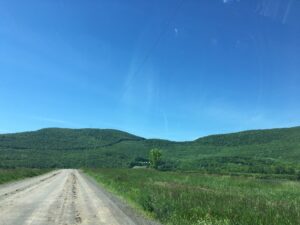
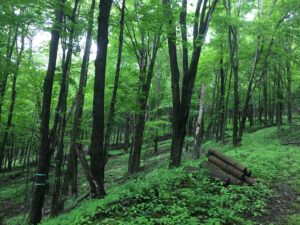
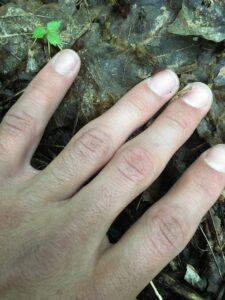
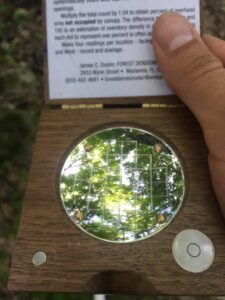

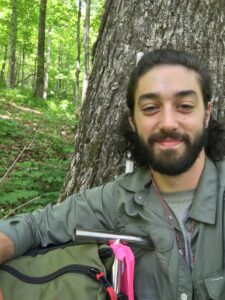
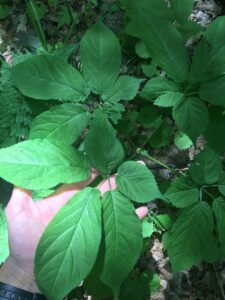
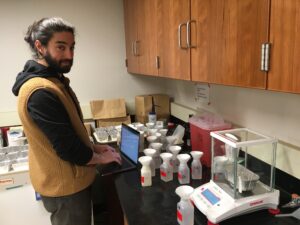
Experimental Design
Every year since 2012 AGP has planted between 16-24 hectares in wild-simulated ginseng on north and east facing slopes where a range of mesic indicator species are present (Table 1). Stratified American ginseng seed is sourced from commercial ginseng farms in Quebec, and is planted beginning in
[1]. The seeds are broadcast by hand by a team of around 10 people, and is done at a rate between 12–40 kg/ha and recorded. Personnel at the farm are trained to broadcast 4-5 seeds per square foot. To control for seasonal affects we conducted this study on all forested areas planted by AGP in 2016 to examine the first 3 years of germination and growth. The total area planted in 2016 was 17.4 hectares distributed across 22 forest stands
ranging in size from 0.03–0.79 ha. The 22 stands were distributed geographically across two larger sites, named Prattsville and Jump Brook. Using the “Create Random Points” tool in ArcGIS, we distributed 65 points across the entire 17.4 hectares. Each point was given a 7.5-meter buffer around it to avoid observational overlap. Each of the 65 random points served as plot center for a round, 10m radius (28.27 m2) fixed-area plot. For ginseng, understory species composition, and environmental measurements five separate circular quadrats each with a radius of 1m were established, one at plot center and the remaining four quadrats three meters from plot center along cardinal directions (north, south, east, west; Fig. 1).
In order to measure ginseng density and vigor, we recorded every ginseng plant with each of the five smaller quadrats. To assess vigor, we counted the number of leaves and measured the width of the central leaflet on each individual ginseng plant. Prior research indicates that the square of the width of the central leaflet across ginseng species is an economical and accurate way to assess leaf area, which itself correlates with root size (Parmenter and Littlejohn 2000).
In order to assess the degree of shade cover at each plot, we used a convex Forestry Suppliers Spherical Crown Concave Densiometer. The tool uses a convex mirror with a grid laid out on it to display the canopy. The user projects four dots in the corners of each unit of the grid, tallies up the dots and multiplies this number by 1.04. This number is subtracted from 100 to give percent shade cover (Lemmon, 1956). We took four measurements—facing north, east, south, and west—of canopy openness at each of the five quadrats, for a total of twenty canopy measurements at each plot. These were averaged to provide one measurement of canopy openness per plot.
For soil measurements, we collected composite soil samples of 15 two-centimeter cores, which represented 3 samples from each quadrat. Each core began below the leaf litter at the Oa horizon and was 12 cm deep. We quantified soil texture with dispersion of soil particles using sodium hexametaphosphate followed by the 1) isolation of the sand fraction using a 0.053 mm sieve, and 2) separation of the silt and clay fractions by settling. Soil pH analysis was done using a modified Mehlich and Morgan Extraction, and percent soil organic matter (SOM) by mass loss on ignition (LOI) at 500°C for 12 hours. The University of Connecticut’s soil analysis lab conducted these analyses.
We quantified soil moisture in multiple ways. First, relative soil moisture was measured in situ as volumetric water content (VWC) using a handheld Hydrosense II Soil Water Content Measurement System (Campbell Scientific, Inc., Logan, UT, USA), with 12cm rods. Three measurements were taken at each of the five quadrats during an extended dry period of at least 72 hours. We conducted all VWC measurements within a two-day window to establish relative soil moisture across plots. Soil samples were used to calculate the water holding capacity of homogenized soils. Subsamples of fresh soil were used to measure field moisture content (105°C for 24 h) and water holding capacity (samples fully saturated, then drained for two hours, and dried at 105°C for 24 hours) (Keiser 2016).
At each 10-meter radius plot, we identified to species and measured every tree at diameter at breast height (dbh, greater than 5 centimeters at 1.3 meters above the ground). We classified each individual as either an arbuscular mycorrhizal fungi (AMF) or ectomycorrhizal fungi (EF) associate using Citation. Within each quadrat we performed presence-absence analysis on the understory plant community using a list of indicator species provided by AGP, itself an aggregation taken from other scientific works and field experience in the Catskill region. From these numbers overall basal area was calculated, as an easily measured proxy variable reflecting a variety of stand traits, tree density and composition, and the ratio of AMF:EF species as a proxy for available microbial partnerships.
Data Analyses
As each of the 22 forest stands planted in 2016 were seeded at a different rate, the number of ginseng plants present in each stand was normalized against seeding rate to allow for cross-stand comparison, by multiplying the seeding rate by the total area of each plot—itself an aggregate of five subplots—and dividing the number of plants present by the new pounds per plot measurement number, normalized across all plots. Plants per pounds of seeds planted, leaf width, and average number of leaves across all plants are the response variables we used for analysis, while the environmental measures recorded—soil nutrients, pH, texture, and moisture; canopy openness; tree associations and microbial partnerships were the independent variables measured.
We examined linear relationships between variables, but additional analysis will be required to disentangle confounding variables. We will perform ANOVA, cluster, and PCA analyses to shed light on the most important factors acting on the response variables (data analysis in progress).
[1] Standard practice is to plant stratified ginseng seeds during the fall—once the tree leaves have begun to fall but before the ground is freezing—but because of the vast areas and large quantity of seed AGP must plant they start earlier in the season.
A generalized description for the development of ginseng over time has the plant emerge in its first year of growth as a trifoliate seedling, with three small leaflets. In its second year of growth the plant adds two additional leaflets to its single leaf, presenting as a palmately compound leaf with five leaflets. During years 3–6 the plant will add an additional palmately compound leaf with five leaflets, and after year 6 may add a third or even fourth leaf (Anderson et al., 2002).
Influence of the interaction between shade and seeding rate on ginseng plant density
Our plots, three years old, contained an average of 49 ginseng plants (sd = 37.732), for an average plant density of 3.13 ginseng plants per square meter. Ginseng plants had an average of 0.42 leaves (sd = 0.230), on a scale from 0 (representing the trifoliate seedling stage) to 3 (the highest number of leaves observed), meaning they averaged between a seedling stage and a single-leafed plant (see Table S1 in supplemental materials). All of our plots were quite shady (% shade 𝑋⎯⎯⎯X_ = 92.2; sd = 1.91) and our analysis indicates a significant positive relationship between the interaction of shade and seeding rate on plant density (Fig. 2, overall model r2 = 0.18, p < 0.001). As shade levels increase from 88 to 96% the marginal benefit of seeding at a higher density decreases until at about 95% canopy shade coverage, where there is no longer any increase in plant density attributable to an increase in seeding rate (Fig. 2). Conversely, as plots become sunnier, planting a higher quantity of ginseng seed resulted in a higher plant density in our 3-year-old plantings. This would corroborate the experience of American Ginseng Pharm General Manager, Anna Plattner, namely that “seeding heavier gives you more plants on your good sites but just as few plants on your bad sites” (Anna Plattner, personal communication). Prior research has suggested that optimal plant spacing is 20 plants per square meter, or approximately two plants per square foot (Li 1995). To achieve this plant density, both research and present practice recommends seeding at a rate of 43–54 seeds per square meter, or 4–5 seeds per square foot (Carroll and Apsley 2013). Across the plots we measured, the seeding rate ranged from 21–70 seeds per square meter, or approximately 2–6.5 seeds per square foot (𝑋⎯⎯⎯X_= 38.056 seeds per square meter, sd = 10.529). In controlled studies, over-sowing of ginseng seed has been shown to decrease plant emergence and root size (Mo et al. 2014), while the clustering of plants in wild populations—though it may simply reflect dispersal limitations (Cruse-Sanders and Hamrick 2004a, b)—could also suggest that ginseng plants are responding positively to favorable microsite conditions (Wagner and McGraw 2013; Wulfsberg 2019). Given that our plots exhibited a relatively narrow range of shade conditions, it is unclear whether the increasing positive effect of seeding density on plant density with decreasing shade levels would continue under sunnier conditions. However, our findings do suggest that on shadier sites, an increase in seeding rate beyond the 43–54 per square meter recommended in the literature would not result in a greater plant density after three years.
It should be noted that the seed planted at our study site was sourced from field-cultivated commercial operations located in Quebec (Anna Plattner, personal communication). These commercial operations, concentrated in Ontario, Canada, and in the state of Wisconsin in the United States, constitute the source of much of the ginseng seed used in forest farming operations (Burkhart et al., 2021). There is debate over whether introducing non-local genetics—from plants cultivated in a highly controlled, industrial environment—could result in ginseng plantings maladapted to local conditions (Burkhart et al., 2021; Schlag & McIntosh, 2012; Schluter & Punja, 2002). It is possible that plants with local genetics may have responded differently to environmental variables on our research sites, but as many forest farmers source their seed from commercial operations we feel our results reflect the planting and plant sourcing conditions most representative of the current active forest farming community (Burkhart et al., 2021).
Influence of forest structure and environmental conditions on ginseng growth and vigor
Results from our regression models show that the effects of environmental conditions do not equally influence ginseng response variables. Our models had the most predictive power when considering the number of ginseng plants, followed by the size of ginseng plants, and lastly the number of ginseng leaves (maturity). We found that across all our analyses, shade levels had the strongest and most persistent effect on ginseng performance (Table 1). For the number of plants, our model had an overall r2 of 0.451, with fixed effects contributing 0.295 and random effects an additional 0.156 to the total variance explained. The most important—in fact, the only significant—variable was shade. For the number of leaves, our model had an r2 of 0.157, with random effects having a negligible contribution to the variance explained. Again, shade was the only variable in the model making a significant contribution. For the average leaf width, our model had an r2 of 0.366, with fixed effects contributing 0.312 and random effects an additional 0.054 to the total variance explained. Shade made the only significant contribution to this model as well (Table. 2).
Our models showed a clear and consistent relationship between the amount of light present in our plots and each of our three response variables indicating ginseng establishment, growth, and vigor. The production recommendations for commercial ginseng growers, using artificial shade structures, suggest the creation of a light environment between 74–82% shade (Ontario Ministry of Agriculture 2001), while present practice among wild-simulated and woods-cultivated growers is to simply use the shade conditions found in American ginseng’s native eastern deciduous forest environment, namely between 70 and 90% shade coverage (Proctor and Palmer 2017; Proctor et al. 1988). These numbers should be understood in relation to the scholarship on light and understory plants. Though there is variation across forest types and understory species, the literature has shown a positive relationship between sunfleck size, intensity, and duration and the carbon gain, growth, and reproductive potential of understory plants (Chazdon, 1988; Chazdon & Pearcy, 1991; Neufeld & Young, 2014; Pearcy & Pfitsch, 1995). However, receiving direct irradiance in the form of sunflecks—which can increase the photon flux density (PFD) two orders of magnitude in a matter of seconds (Chazdon, 1988)—induces high level of physiological stress, and during exposure to the more direct sunlight of a sunfleck photosynthesis may be limited by high leaf temperatures and transpiration rates, which can cause permanent heat damage, stomatal closure, and wilting (Chazdon & Pearcy, 1991; Rackham, 1975; Woodward, 1981; Young & Smith, 1979). Efficiency of sunfleck use and tolerance to the potentially damaging effects of direct sunlight during prolonged exposure vary both between understory species as well as within a given species during different phases of growth and under differing site conditions (Chazdon, 1988; Chazdon & Pearcy, 1991). The research on the relationship between light availability and plant growth for understory species that co-occur with American ginseng in the Eastern United States has been mixed. Dion et al. (2017) found that greater light levels reaching the forest floor during the growing season—due to a forest canopy composed of species with late-season budburst—led to higher levels of growth in transplanted forest populations of Allium triccocum. Meanwhile, Sanders and McGraw (2005) found no relationship between light levels and growth of transplanted forest populations of Hydrastis canadensis, though higher light levels did correlate with smaller leaf area. Research on the effect of high light levels on Panax ginseng has shown that they cause photoinhibition, reduced leaf size, and early senescence, while also resulting in higher rates of photosynthesis, leaving somewhat open the question of whether a high light environment leads to faster growth rates (Parmenter & Littlejohn, 1998, 2000).
More recent research has suggested that American ginseng growth rates are positively associated with greater light from sunflecks—though seed germination was found to be negatively associated with increased light—and that an increased light environment resulting from timber harvesting can lead to these increased growth rates (Chandler and McGraw 2015; Wagner and McGraw 2013). Drawing from these studies indicating that ginseng may benefit from a higher light environment, Proctor and Palmer (2017) sought to establish, for the first time, the optimal light requirements for ginseng seedlings grown in greenhouses. They found that the optimal shade level for growth was 65.4%. This study, however, took place in a highly controlled environment and only examined plants in their first year of growth. The authors noted that the optimal light level for growing ginseng is determined by a “combination of plant responses to light, and the associated specific environmental and plant health issues at that location.”
One notable feature of our study site was its high degree of shade. Trees per hectare averaged 427 (sd = 124), while basal area averaged 28.7 m2 per hectare (sd = 7.95). Across the plots we measured, shade levels ranged from 87.9 to 95.9% (𝑋⎯⎯⎯X_= 92.3, median = 92.1, sd = 1.9), in comparison to the 70–90% considered “natural” in Eastern deciduous mature, closed canopy forests (Proctor and Palmer 2017). Across all of our analyses, the degree of shade cover had a persistent, negative relationship with number of ginseng plants, maturity of ginseng plants, and width of ginseng leaves (Fig. 3). The strength of these relationships, and their statistical significance suggest that sunlight was operating as the limiting environmental factor in the establishment, growth, and development of ginseng plantings in comparison to the other environmental variables in our study site. This finding suggests an opportunity for forest farmers to implement silvicultural techniques to provide additional sunlight in the understory, which has been shown to have a positive effect on ginseng growth (Chamberlain et al. 2018; Chandler and McGraw 2015; Fournier et al. 2008, 2004).
While greenhouse research has indicated that optimal light levels for ginseng seedlings could be as low as 65.4%, in a wild-simulated forest environment increased light from canopy gaps could lead to greater interspecies competition with ginseng plantings in the understory (Beckage et al. 2011). Additionally, the uniform quality of light coming through shade cloth is different than the more variable light environment of a forest, where understory plants have evolved physiological mechanisms to respond to sunflecks (Chazdon and Pearcy 1991; Wagner and McGraw 2013). More experimentation in wild-simulated ginseng plantings is necessary to identify the optimal light levels for stimulating ginseng growth in a natural forest environment while maintaining relatively low levels of interspecies competition. However, utilizing silviculture that minimizes forest floor disturbance and mimics old-growth canopy structure to produce a timber crop within wild-simulated ginseng plantings has the potential to improve the value of a ginseng crop while creating an additional revenue stream from timber (Chandler and McGraw 2015; Peever 2004).
The role of soil characteristics on Ginseng growth
On the whole, the soils in our study site were very acidic (pH 𝑋⎯⎯⎯X_= 4.01, sd = 0.32), Soil texture is a loam, averaging 47.6% sand (sd = 6.44), 14.6% clay (sd = 3.55), and 37.9% silt (sd = 4.45). Soils had moderate levels of calcium and potassium averaging 1530 kg/ha (sd = 943) and 154 kg/ha (sd = 43.6) respectively, and high levels of aluminum (aluminum ppm 𝑋⎯⎯⎯X_= 118.95, sd = 54.39). Our results showed that levels of calcium and aluminum were highly negatively correlated in our plots (Pearson correlation coefficient = -0.76; Fig. S1). Meanwhile, calcium had a significant but only slight positive relationship with average ginseng center leaflet width (Coefficient = 0.00013, r2 = 0.0805, p < 0.05), while it had no significant relationship with either the number or maturity of ginseng plants. The relationship between calcium and aluminum in acidic forest soils is well understood (Rengel 1992). While visible signs of aluminum toxicity were not observed in the field, aside from small size of the three-year-old ginseng plants in many plots, prior research in wild-simulated forest plantings of American ginseng in highly acidic soils has shown that increasing calcium levels and raising soil pH through the application of lime (calcium oxide) both lowers soil Aluminum levels and increases ginseng leaf area, as well as plant emergence, survival, and shoot and root mass (Nadeau et al. 2003; Nadeau et al. 1998; Olivier et al. 2005; Peever 2004). Given that our data did not reveal a meaningful relationship between these soil properties and ginseng performance, we can draw two conclusions with management implications for wild-simulated ginseng growers who have more marginal planting sites: 1) on the one hand, our study shows that it is indeed possible to grow ginseng without soil amendments on acidic soils that exhibit a range of soil calcium and aluminum levels, and 2) on the other hand, it is also possible that the ginseng plants across our study sites would have experienced a boost in performance through the practice of liming.
This relationship between calcium and ginseng performance is well documented in the literature. Stoltz (1982) found that the withholding of calcium led to slower growth and earlier foliar deficiency symptoms than when N, P, or Mg were withheld. In wild-simulated research trials, it has been found that adding calcium by liming the soil resulted in improved ginseng survival and growth (Nadeau et al. 2003; Nadeau et al. 1998; Slak 2005). Research by Robert Beyfuss (2000) suggested that sites with the highest levels of calcium produced the largest ginseng roots. And calcium is also known to decrease aluminum toxicity, which is a major limiting factor for plant growth and crop production in strongly acidic soils (Foy 1992; Nadeau et al. 1998). Building off of Beyfuss (2000) and Persons and Davis (2014), Burkhart (2013) identified a threshold of 3,360 kg/ha for identifying promising sites for planting ginseng. In spite of these prior findings, and given that our sites were quite acidic, our data did not indicate that calcium had a major role in determining plant size, survival, or maturity.
In this study, we examined the relationships between a range of environmental conditions and plantings of wild-simulated American ginseng in an observational study on an active ginseng farm. Because this study was not a designed experiment there are some limitations. First, while we had an overall seeding rate per stand, given the heterogeneity of the planting sites sampled in our study (with boulders, fallen trees, ephemeral streams, etc.) seeds could not be broadcasted evenly across the landscape. This meant that we could not directly calculate measures such as survival or establishment, and instead could only determine relative success. We attempted to compensate for these challenges by incorporating random effects into our models and eliminating plots where it was clear that no seeds had been planted, but future work seeking to address similar questions could set up controlled germination studies to generate findings of greater specificity. Second, as our plots were all located on sites deemed appropriate for planting by AGP, the variability across our sites was not very high for some of the environmental variables we measured. Shade levels varied between 87 and 96% across our plots, while pH varied between 3.6 and 5.2, to take two examples. This lack of variability likely obscured the full depth of the relationships between our environmental and ginseng response variables. Taking measurements in wild-simulated plantings of ginseng across a greater range of site conditions would provide a fuller picture of these relationships. Overall, we feel that the benefits of doing these studies on active farms outweighs the limitations and provide important data for farmers by examining what is currently working in the field and therefore suggest that future work should include both carefully controlled experiments along with observational studies to better understand the mechanisms at play in these systems.
Our results suggest that a mature, closed canopy forest may require silvicultural thinning in order to maximize ginseng performance. While wild-simulated ginseng production is by definition a hands-off approach to the forest cultivation of ginseng, the clearing of ferns, brush, and small diameter trees falls under the purview of the practice. A light thinning of trees in areas devoted to wild-simulated production could provide additional opportunities for sustainable income generation in the form of wood products or additional non-timber products such as mushrooms produced from inoculated logs. Further research is needed to determine whether it is preferable to remove canopy trees or understory trees to create additional sunlight. And although laboratory research indicates that ginseng seedlings may grow the fastest under 65.4% shade, introducing significant light to the understory in a forest would likely lead to greater levels of competition (Proctor and Palmer 2017). Thus, forest-based research is needed to determine the optimal level of sunlight that balances ginseng survival, growth, and development with inter-species competition. Additionally, follow-up research on the interaction between light levels and seeding rate and the subsequent effect on establishment could help forest farmers decide how much seed to plant on a given site, and whether that decision should be influenced by light levels and a desire (or lack thereof) to modify the light environment via thinning.
Our study also found that it is possible to cultivate ginseng on highly acidic sites with lower levels of calcium and higher levels of aluminum that the literature has identified as optimal. This is not a given—Olivier et al (2005) found that five years after planting ginseng on acidic sites in Canada, their control plots (no modifications) had no ginseng plants that survived. Our study leaves open the possibility that modifying calcium levels on highly acidic soils, through the application of lime, could result in a higher pH and increased performance of ginseng plantings. As the wild-simulated cultivation of American ginseng becomes increasingly global, our findings suggest that forest farmers interested in the productivity and profit potential of their operations should consider not only using indicator species to identify planting sites, but investing in handheld tools such as a densiometer and a pH meter. And they should consider site modifications such as thinning and lime application viable strategies for increasing the performance of wild-simulated ginseng plantings on shaded and acidic sites.
Education & Outreach Activities and Participation Summary
Participation Summary:
(Picture taken during a presentation at the Perennial Farm Gathering virtual conference, held Dec. 6-9, 2020)
Over the course of this project I was able to make many connections with farmers and forest landowners, as well as community members and technical service providers.
Despite the difficulties brought on by COVID-19, I was able to make substantial progress in 2020. I presented the results of my project at the Perennial Farm Gathering conference, held Dec. 6-9, 2020, co-sponsored by the Association for Temperate Agroforestry (AFTA) and the Savanna Institute, to a group of 42 farmer and agricultural service providers. Through a partnership with the farm managers at American Ginseng Pharm, they wrote up articles highlighting this research in AFTA's newsletter, The Temperate Agroforester, and in the newsletter of United Plant Savers. I gave a lecture on my SARE-funded research in a graduate-level seminar course "The Science and Practice of Temperate Agroforestry" offered at the Yale School of the Environment, to a group of 22 students studying forestry and sustainable land management in the fall of 2020. I presented at the New England Society of American Foresters (NESAF) conference on March 22nd of 2021 to a group of 24 participants. I spoke at the Summer Research Seminar series held through the Quiet Corner Initiative (QCI) at the Yale-Myers Forest in Eastford, CT at an event drawing from QCI's membership made up of farmers and private forest landowners, to a group of 14 students and forest landowners from the community. And on December 17th of 2021 I presented at the Forest Ecosystem Monitoring Cooperative's annual conference, to a group of 35. The conference theme was "Facing change: Reimagining forested communities in a time of disruption."
Finally, I synthesized the results of this project into a peer-reviewed research article published in the journal Agroforestry Systems in November of 2021. The article is titled "Importance of Environmental Factors of Plantings of Wild-Simulated American Ginseng."
Project Outcomes
This project provided us with practical insight into ways that farmers can more efficiently and effectively approach the intentional cultivation of ginseng in their woodlots using a wild-simulated technique. The results of our research indicate that the integration of silvicultural techniques, namely the light thinning of trees in the forested area where ginseng is being planted, in order to increase the levels of sunlight reaching the forest floor, would have a significantly positive effect on ginseng survival, growth, and development. It also creates additional opportunities for low-impact income generation through the selective harvesting of trees from the forest. This could range from merchantable saw-logs to small-diameter trees that could be used for mushroom cultivation or as firewood. This type of low-impact management has few barriers to entry, and constitutes an easy intervention for forest farmers that our research indicates will have a positive impact on the success of their wild-simulated plantings.
This project has been incredibly fruitful, in multiple ways. The research funded through this project led to published research and a number of insightful takeaways for current and prospective American ginseng forest farmers:
- In our study, levels of canopy shade were revealed to be the single largest factor in determining the establishment, size, and maturity of planted American ginseng in a forest environment. While conventional wisdom around selecting a good ginseng site suggests 70-90% shade cover is optimal, our research sites were quite shade, on the order of 86-96% shaded. Across our tests, the more sun our plots received the better the ginseng plants were doing. This suggests that forest farmers with especially shaded sites may consider a light thinning of the canopy or midstory to allow higher light levels to reach their ginseng plantings to increase establishment, maturation, and growth.
- We found that as our plots got shadier, the marginal benefit of planting more ginseng seed decreased. In other words, in sunnier plots planting more seed led to having more plants after three years. In our shadier plots, it didn't matter how much seed was planted, the number of plants that established after 3 years stayed the same. This suggests that forest farmers shouldn't bother planting more seed on their shadiest sites to compensate for slow growth rates – a lack of sunlight is negatively affecting ginseng establishment.
Like all good research, this project has raised as many questions as it answered, which has generated new research questions to be taken up by myself and/or other students at Yale's School of the Environment through the relationship between myself, my advisor, and other faculty at the school. This project has also raised the profile of agroforestry at Yale's Forest School, where the topic has been growing as an area of research and practice on the school's forest properties. My own career trajectory has been directly shaped by this project. From working on this project, I launched into a post-graduate fellowship position with the school and submitted another SARE proposal, which was funded (Project LNE21-423: The Northeast Forest Farmers Coalition: Creating a Community of Practice). This project expands this graduate student research to a greater number of commercially significant understory species planted in research sites ranging throughout the Northeast, at the same time that it brings forest farmers in the region into a Northeast Forest Farmers Coalition. This project brings together many different groups–from universities to nonprofits and businesses–to carry this work forward in the form of both research and education for forest farmers.
I am currently working for a nonprofit organization, Rural Action providing technical assistance to forest farmers, and forging a new working relationship between Rural Action and Yale University through SARE funding. This project is what started that all!
